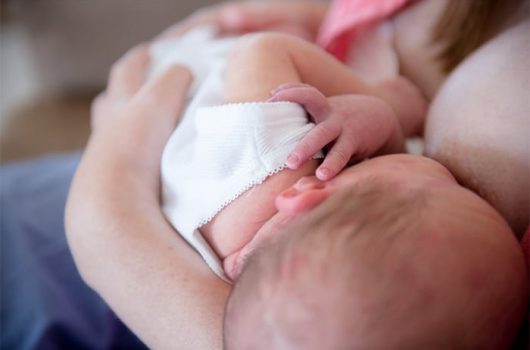Cracked nipple, or nipple trauma, is a painful breast disorder that can occur in women who are breastfeeding for many reasons. But cracked nipples or breast soreness aren’t an inevitable outcome of breastfeeding. Although this condition is common, it’s a sign that something’s not right.
Symptoms of cracked nipples or nipple trauma
- Bleeding of one or both nipples during breastfeeding.
- Pain, which can be severe during nursing.
- Dryness of the nipple.
- Irritation of the nipple.
- Cracking or breaks in the skin of the nipple.
- Ulceration, in some cases.
- Oozing of the nipple.
- Throbbing
- Boils
Causes of cracked nipples
The most common causes of cracked and traumatized nipples are poor latching at the breast, and suction trauma from improper positioning. Babies who aren’t properly latched might pinch the nipple to protect themselves from forceful letdown reflexes. Also, if the baby has a shallow latch, they will nurse more often because they aren’t getting as much milk from each breastfeeding session.
The most common cause is that the baby is not taking the nipple deeply enough into their mouth. The entire nipple and part of the breast should be in the baby’s mouth so that the nipple is near the back of the baby’s mouth.
According to La Leche League International, a baby will pinch their mother’s nipple because of anatomical problems including:
- Tongue-tie
- Small mouth
- Receding chin
- Short frenulum
- High palate
- Other possible causes include:
- Nipple confusion
- Sucking problems
- Baby retracting or improperly positioning their tongue during nursing
The most important thing to do is to find out what is causing your cracked so that it doesn’t happen again. The best thing to do is to speak to a lactation consultant who can assess your breastfeeding and the baby’s latching and sucking patterns.
Treatment for cracked nipples
There are several remedies for sore, cracked nipples. See what works for you.
Change your nursing pads frequently
As soon as a nursing pad becomes damp, change it. If your nipples are constantly damp, it can delay the healing process. Also, don’t use nursing pads that have plastic linings. These can stop airflow. Use pads that are 100 percent cotton.

Apply a warm compress
Although a warm compress doesn’t have any antibacterial benefits, you might find it soothing for your cracked, sore nipples. To do this, dip a clean washcloth in warm water and wring out. Place the cloth over your nipple and breast for a few minutes. Repeat for the other breast. Pat dry afterward.
Rinse with salt water
You can make this saline solution in your kitchen to help to hydrate the skin and promote healing. Salt also has antibacterial qualities. Mis ½ teaspoon of plain salt in 8 ounces of warm water. Soak your nipples in a small bowl of this warm saline solution for about a minute or two after breastfeeding.
You could also use a spray bottle to spray on the solution. Pat dry afterward. Note that it’s important to make a fresh batch of saline solution every day to reduce the chances of bacterial contamination. Your baby might not like the taste of the dried solution on your nipple. If so, rinse your nipples before feeding.
Apply lanolin
You can buy lanolin ointment that has been specifically developed for breastfeeding mothers. It helps to promote the healing of moist wounds. Apply to your nipples after breastfeeding. You don’t need to wipe it off before nursing.
Apply breast milk
After breastfeeding, express a little breast milk and smooth it onto your nipples. This can help heal them because of the milk’s antibacterial properties. Make sure your hands are freshly-washed and allow the milk to air-dry before you cover up. If you have thrush, do not use this method. Rinse your nipples with fresh water after feeding your baby as yeast grows quickly in human milk.
